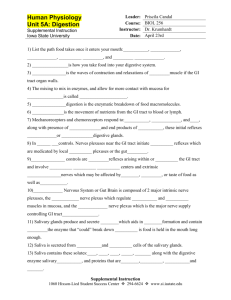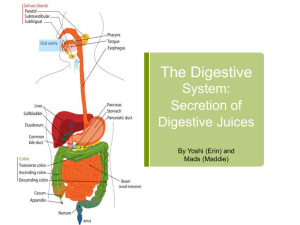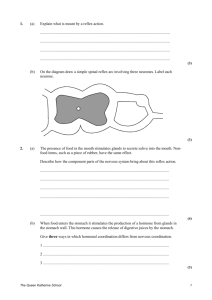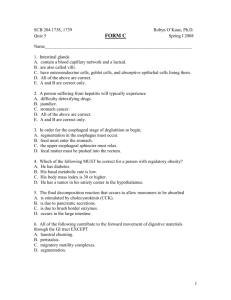Physiology III Gastroinstestinal System
advertisement
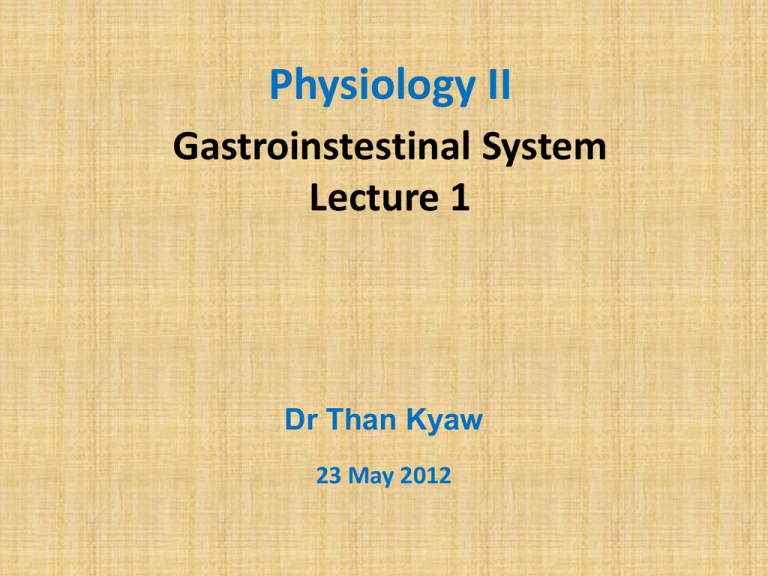
Physiology II Gastroinstestinal System Lecture 1 Dr Than Kyaw 23 May 2012 Introduction Gastroinstestinal System (Alimentary system, Digestive system) • Living things – the most important = to live • Need to – eat food – digest it – use digested materials for body building, maintenance, production • Without food – survive for a few days/month – use body stores and tissues Introduction • • • • • Know the order of principle parts of Alimentary (GI) tract Carnivorous – flesh eating Herbivorous – plant eating Omnivorous – eat both flesh and plants Digestive systems develop differently in different spp. e.g. Cecum of horse (large) but of dog (very small) (why?) - functional need/amount of fermentation required Functional Anatomy of GI Tract 1. Oral cavity (Mouth) Teeth Tongue Pharynx 2. Stomach Esophagus Simple & compound stomach 3. Intestines Small Large 4. Accessory organs Salivary glands Pancreas Liver Oral cavity - Most cranial part - Food is first received - Teeth and tongue - assist digestion Teeth - cutting - reduce the size of ingested food particles by grinding - increase surface areas – chemical + microbiologic degradation Types of teeth • Incisors (nippers): most forward teeth; for cutting • Canine teeth (tasks, fangs, eye teeth) - tearing and separation of food • Premolars - caudal to the canines - grinding • Molars - grinding • Premolars & molars = cheek teeth TEETH (INCISORS) Carnivore Herbivore Omnivore Human Short and pointed Broad, flattened and spade shaped Short and pointed Broad, flattened and spade shaped TEETH (CANINES) Carnivore Herbivore Omnivore Human Long, sharp and curved Dull and short or long, or none Long, sharp and curved Short and blunt TEETH (MOLARS) Carnivore Herbivore Omnivore Human Sharp, jagged and blade shaped Flattened with cusps, complex surface Sharp blades and/or flattened Flattened with nodular cusps Dental formulas Dental formulas: domestic animals (permanent teeth) -One side of the jaw - Numerator = upper jaw - Denominator = lower jaw (A) Cow* (B) Horse *Note: Cow, sheep and goats have no upper incisors; but a dental pad (C) Sheep (D) Pig (E) Dog - Upper cheek teeth – slightly wider apart than lower arcade – also has wider table (grinding surface) than lower teeth - In horse - uneven wear (hooks) - points are formed - cause injury to the bucal or lingual membranes - painful, unable to eat - filing off the points with a dental rasp (floating of the teeth) Horse: formation of points Reece (2009) Eruption of teeth and age • Age of animal estimated by the stage of eruption • E.g: cow (permanent teeth eruption) Tooth I1 I2 I3 I4 Age 1½ - 2 y 2 - 2½ y 3y Tooth P1 P2 P3 Age 2 - 2½ y 1½ - 2½ y 2½ - 3 y Tooth M1 M2 M3 Age 5 – 6 mth 1½ y 2 - 2½ y 3½ - 4 y • Search and observe dentition for other animals • Muscles related to chewing Tongue Muscular organ - longitudinal - Circular - transverse Extremely mobile What does a tongue can do? - Maneuver food mass - seize - bring into the mouth - move food to the table surfaces of teeth - swallowing - gustation (taste) - clean the fur and body - remove oil and parasites - catching the prey - heat regulation Taste buds on the tongue • Numerous projections – k/s papillae - for traction of food - grooming of the offspring • Types of Papillae - Vallate: Large circular projections surrounded by a deep groove - Fungiform: like tiny mushroom - Filliform: pointed projection - Folliate: like leaf - Conical: cone shaped Nerve supply - Facial nerve (VII) - Glossopharyngeal nerve (XI) Taste buds - Chemical senses - Important for feed intake of man and animals • Abundant in - Vallate, folliate and fungiform papillae - Soft palate - Parts of pharynx - Epiglottis - Larynx Taste Buds, Taste Receptor Cells, and Taste Nerves The sense of taste - mediated by taste receptor cells which are bundled in clusters called taste buds. Taste receptor cells sample oral concentrations of a large number of small molecules and report a sensation of taste to centers in the brainstem. Number of taste buds Cattle – 25000 Pig - 15000 Cat - 470 Chicken – 30 Goat - 15000 Man - 8,000 - 10,000 Catfish - 100,000 – 175,000 Examples of some human thresholds of taste Threshold for Taste Substance tasting Salty NaCl 0.01 M Sour HCl 0.0009 M Sweet Sucrose 0.01 M Bitter Quinine 0.000008 M Umami Glutamate 0.0007 M Pharynx • Common passage to air and food - Naso-pharynx - Oro-pharynx - Laryngo-pharynx • Responsible for the proper directing of - air to the air passage - food and liquid to the esophagus Mastication and Deglutition (Chewing and swallowing) • Mechanical breakdown of food (chewing) • Fibrous food – require more chewing • Bolus (round/oval) mixed with saliva - mucus: adhesion & lubrication for ease of swallowing Swallowing (deglutition) - co-ordinated with swallowing center in the brain - Mouth – voluntary initiation - Pharynx – reflex action - Esophagus - reflex - Unconsciousness – danger of inhaling vomitus due to – lack of voluntary control - depressed reflex centers Swallowing (deglutition) The sequences of reflexes: 1. Respiration inhibited (danger of inhaling food minimized) 2. Glottis (opening to larynx) closed 3. Larynx - pulled upward and forward 4. Root of tongue – fold the epiglottis over the glottis as the tongue plunges the bolus from mouth to pharynx 5. Soft palate – elevated; close the nasal cavity from pharynx 6. Peristaltic contraction of pharynx – directs food from pharynx to esophagus 7. Reflex peristaltic wave – initiated, transport bolus to stomach Salivary glands and saliva 3 paired, well defined salivary glands 1. Parotid - Serous (watery, clear fluid) 2. Sublingual - Mucous (viscid, tenacious and protective) 3. Mandibular - mixed (serous and mucous) Autonomic nerve supply (symp- and parasymp) Salivary glands of dog Zygomatic Parotid Mandibular Sublingual Duct of sublingual gland Salivary glands of horse 1 Parotid gland. 2 Molar glands. 3 Sublingual gland. 4 Parotid Duct. 5 Masseter muscle. 6 Facial nerve. 7 Jugular vein. 8 Submaxillary vein. 10 Labial glands. 11 Labial ducts. 1 Submaxillary gland. - - Submaxillary duet (Wharton's duct). 3 Cluster of openings of ducts of sublingual glands. 4 Tongue. 5 Circumvallate papilla. 6 Fungiform papillae. 7 Jugular vein. 8 Submaxillary vein. Salivary glands and saliva Saliva contains: water Electrolytes Mucus and Enzymes – amylase (present in pig; absent in ruminants and dog) Amount of saliva - greatest in herbivores - 80% of water entering the stomach in cattle is provided by saliva Salivary glands and saliva Species Ox Cow Sheep Goat Secretion Parotid Mixed Parotid Parotid ml/hr Total/day 800-2400 56 kg 50 gl 4 to 25 10 to 60 Salivary glands and saliva Function of saliva • buffering action in ruminants (neutralize acids produced by fermentation) pH 6.2 – 6.8 • Digestion of carbohydrate by amylase • evaporation and cooling in panting animals Esophagus • Muscular tube – from pharynx to stomach through thoracic cavity, diaphragm • Constriction waves of muscular contractions (peristaltic movement) Peristalsis • both longitudinal and circular muscle fibers propel the ingesta, consisting of a wave of contraction passing along the tube. • Increased peristalsis means faster movement of ingesta through the gut and less absorption of fluid, both tending to diarrhea. • Reduced peristalsis means a longer alimentary sojourn, greater inspiration of ingesta and a tendency to constipation. Circular muscle contraction Bolus Circular muscle relaxation Antiperistalsis / Reverse peristalsis • peristalsis directed orally (reverse of going to stomach) • Result of intestinal obstruction and acute, significant distention of the intestinal lumen • May also rise from mild digestive upsets • Major contributing mechanism in vomiting. Vomition (Emesis) - forceful expulsion of the contents of one's stomach through the mouth and sometimes the nose - Protective response to remove potentially harmful ingesta from the stomach and upper small intestine - Relaxation of upper and lower esophageal sphincters, glottis, nasal cavity - Reflex action through vomiting center in the brain Regurgitation vs. vomiting •Rregurgitation: - passive expulsion of ingested material out of the mouth - normal component of ruminant digestion for cud chewing - Cattle and horses vomit rarely - Dogs and cats vomit easily and frequently, Stomach • Simple stomach • Complex stomach E C F B P ? E = Esophagus C = Cardia F = Fundus B = Body P = Pylorus Simple stomach and digestion • Dilated portion • Store ingesta temporarily • Contract and mix food with gastric juice Chyme Gastric juice Gastric glands in regions of Cardia Fundus pylorus Water Mucus HCL Pepsinogen renin Simple stomach Regulation of gastric secretion Cephalic phase(stimulatory) Smell, Sight, taste, Thinking of food Intestinal phase (inhibitory) Gastric phase (stimulatory) Presence of food in the stomach (stretch) Pyloric gland (G cells) Parietal cells Chief (peptic) cells Cholecystokinin and secretin (hormones released by duodenum) Gastrin (hormone) HCL Pepsinogen (proteolytic enzyme) Simple stomach Cephalic phase 1. Smell, 2. Seeing, 3.taste Parasympathetic (vagal) sti medulla oblongata 4. Thinking of food endocrine cells in the stomach Gastrin secretes gastric juice stomach circulatomry system Circulation Sti gastric juice secretion Brain Stretch Brain Stomach Smell, taste, seeing, thinking Stomach Acidity Carnivore Less than or equal to pH 1 with food in stomach Herbivore pH 4 to 5 with food in stomach Omnivore Less than or equal to pH 1 with food in stomach Human pH 4 to 5 with food in stomach COW: Bite size >1.5 inches (25,000 to over 40,000 prehensile bites) >1/3 = grazing 1/3 = cud chewing <1/3 = idling Simple stomach Pepsinogen - proteolytic enzyme - inactive form - initial (partial) digestion of proteins Protein in bolus Pepsinogen Activated by HCl pepsin Peptide Gastric emptying • Powerful contractions of gastric smooth muscle - Crushed, ground, mixed and liquefy the ingesta to form chyme - chyme is forced through the pyloric canal into the small intestine (gastric emptying) - 3 times/min in man; 5 to 6 times/min in dogs • Neural and hormonal control (enteric and vagus nerve); receptors present in the duodenum Stomach of horse Gastric emptying • rate of gastric emptying - strongly influenced by both volume and composition of gastric contents • Liquid food faster movement (e.g. water) - unnecessary to crush or grind • Solid and large vol. of ingesta - take longer time • Solid and smaller amount stay long as less gastric reflex Mechanism of delay in gastric emptying • Sufficient delay time is necessary for adequate digestion of ingesta • This is accomplished by 2 reflexes• Enterogastric reflex (neural) - osmoreceptors in duodenum respond to hypertonic contents (products of protein and C/H digestion; electrolytes) - H+ receptors in duodenum respond to high H+ conc. • Enterogastrone reflex (endocrine) - Cholecystokinin – released from duodenum in response to lipid entering the duodenum - GIP (gastric inhibitory peptide) released from jejunum in response to lipid and C/H To be continued to lecture 2 Next week
